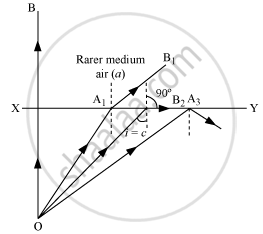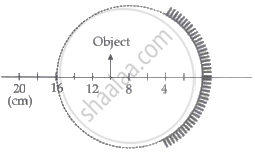Advertisements
Advertisements
Question
Answer the following question.
Under what conditions is the phenomenon of total internal reflection of light observed? Obtain the relation between the critical angle of incidence and the refractive index of the medium.
Solution
Total Internal Reflection:

Total internal reflection is the phenomenon of reflection of light into a denser medium from an interface of the denser medium and the rarer medium. Two essential conditions for total internal reflection: Incident ray should travel in the denser medium and refracted ray should travel in the rarer medium.
The angle of incidence (i) should be greater than the critical angle for the pair of media in contact.
The relation between refractive index and critical angle (C):
When i = C and r = 90°
Apply Snell's law
`mu_b sinC = mu_a sin90^circ = mu_a xx 1`
`mu_b/mu_a = 1/sin C`
`""^amu_b = 1/sin C`.
RELATED QUESTIONS
A converging lens of focal length 40 cm is kept in contact with a diverging lens of focal length 30 cm. Find the focal length of the combination .
How can the spherical aberration produced by a lens be minimized?
Answer the following question.
With the help of a ray diagram, obtain the relation between its focal length and radius of curvature.
Focal length of a mirror is given by ______.
According to the mirror equation, ______.
A thin converging lens of focal length 12 cm is kept in contact with a thin diverging lens of focal length 18 cm. Calculate the effective/equivalent focal length of the combination.
The focal length of a convex lens made of glass of refractive index (1.5) is 20 cm.
What will be its new focal length when placed in a medium of refractive index 1.25?
Is focal length positive or negative? What does it signify?
An astronomical refractive telescope has an objective of focal length 20 m and an eyepiece of focal length 2 cm.
- The length of the telescope tube is 20.02 m.
- The magnification is 1000.
- The image formed is inverted.
- An objective of a larger aperture will increase the brightness and reduce chromatic aberration of the image.
A spherical mirror is obtained as shown in the figure from a hollow glass sphere. if an object is positioned in front of the mirror, what will be the nature and magnification of the image of the object? (Figure drawn as schematic and not to scale)

A converging lens has a focal length of 10 cm in air. It is made of a material with a refractive index of 1.6. If it is immersed in a liquid of refractive index 1.3, find its new focal length.
